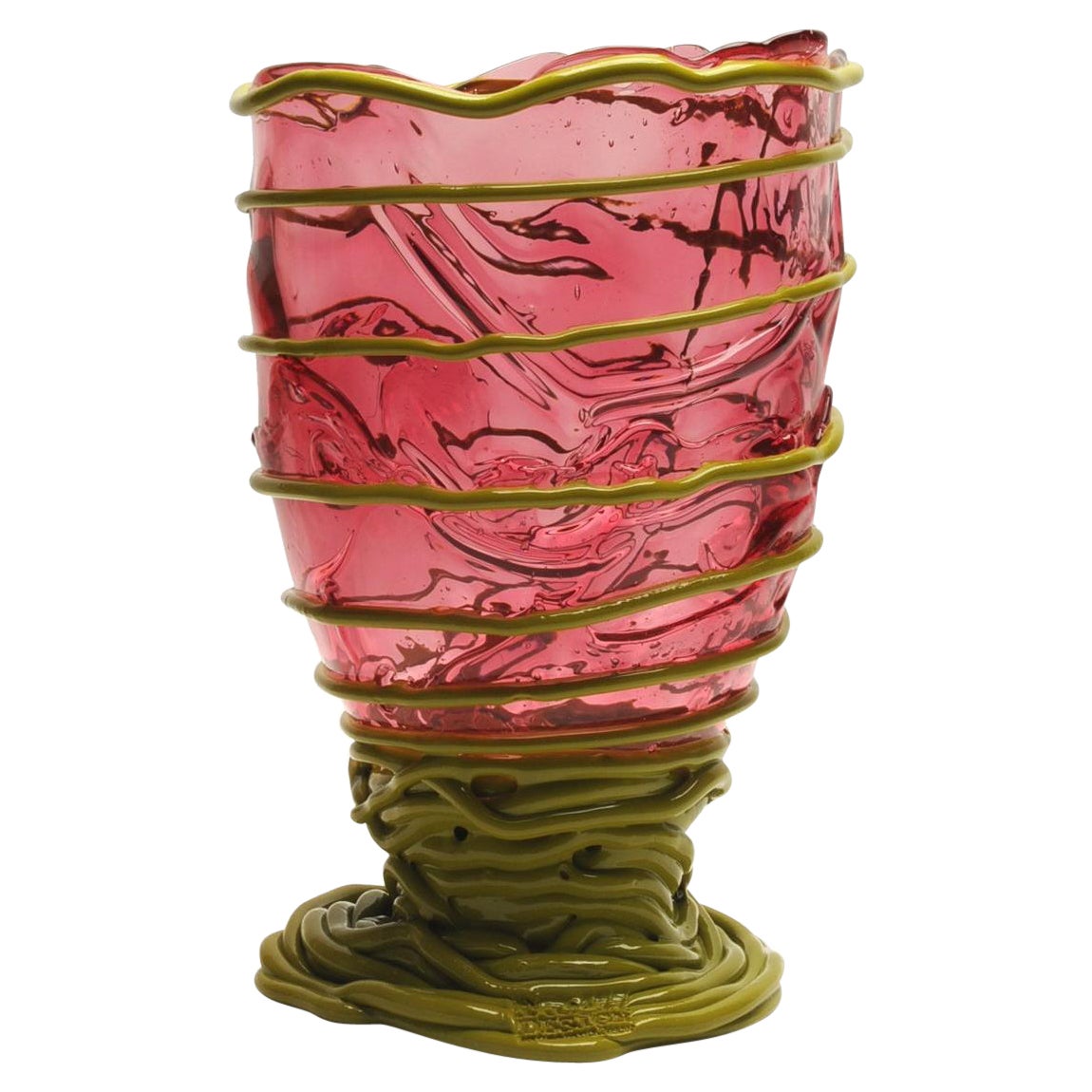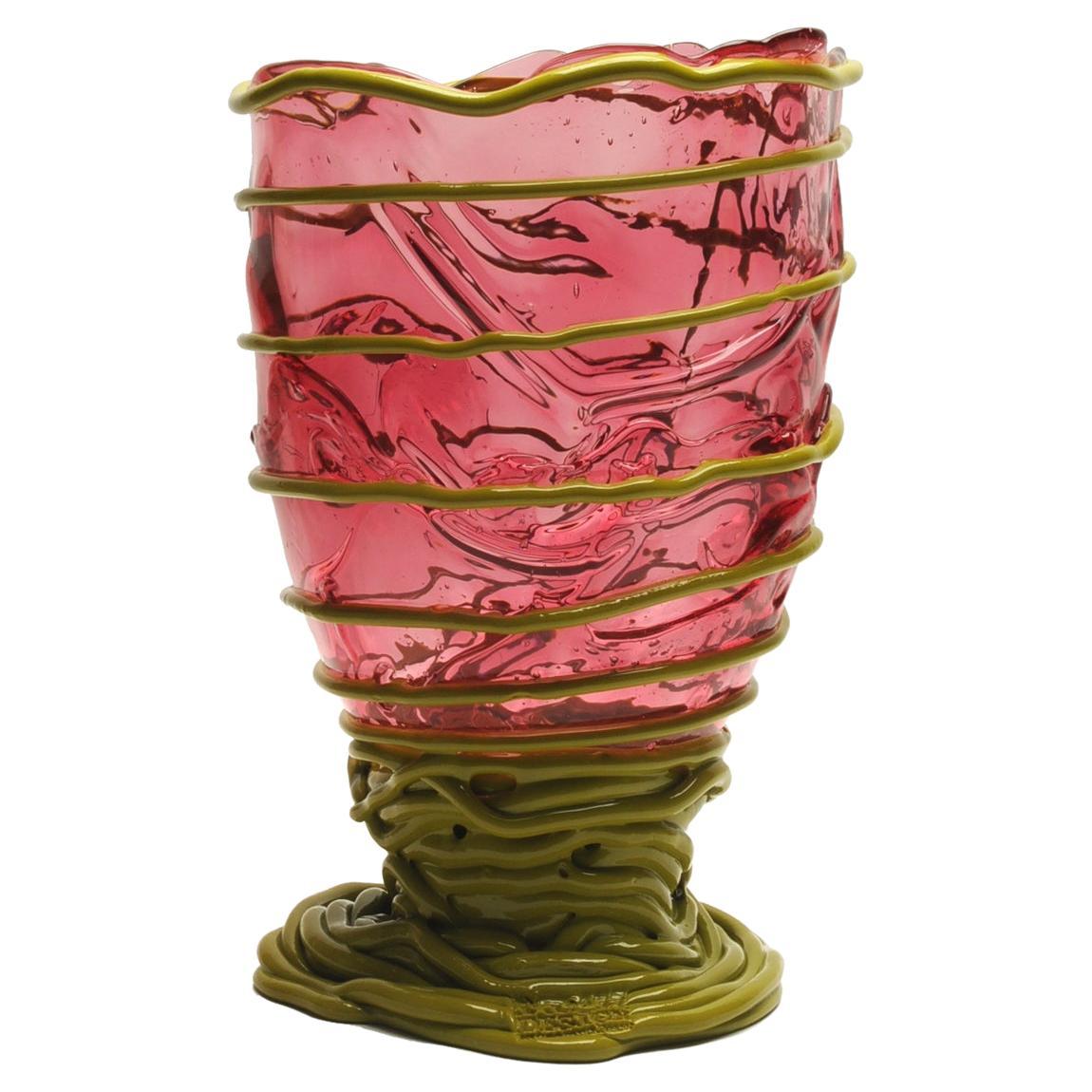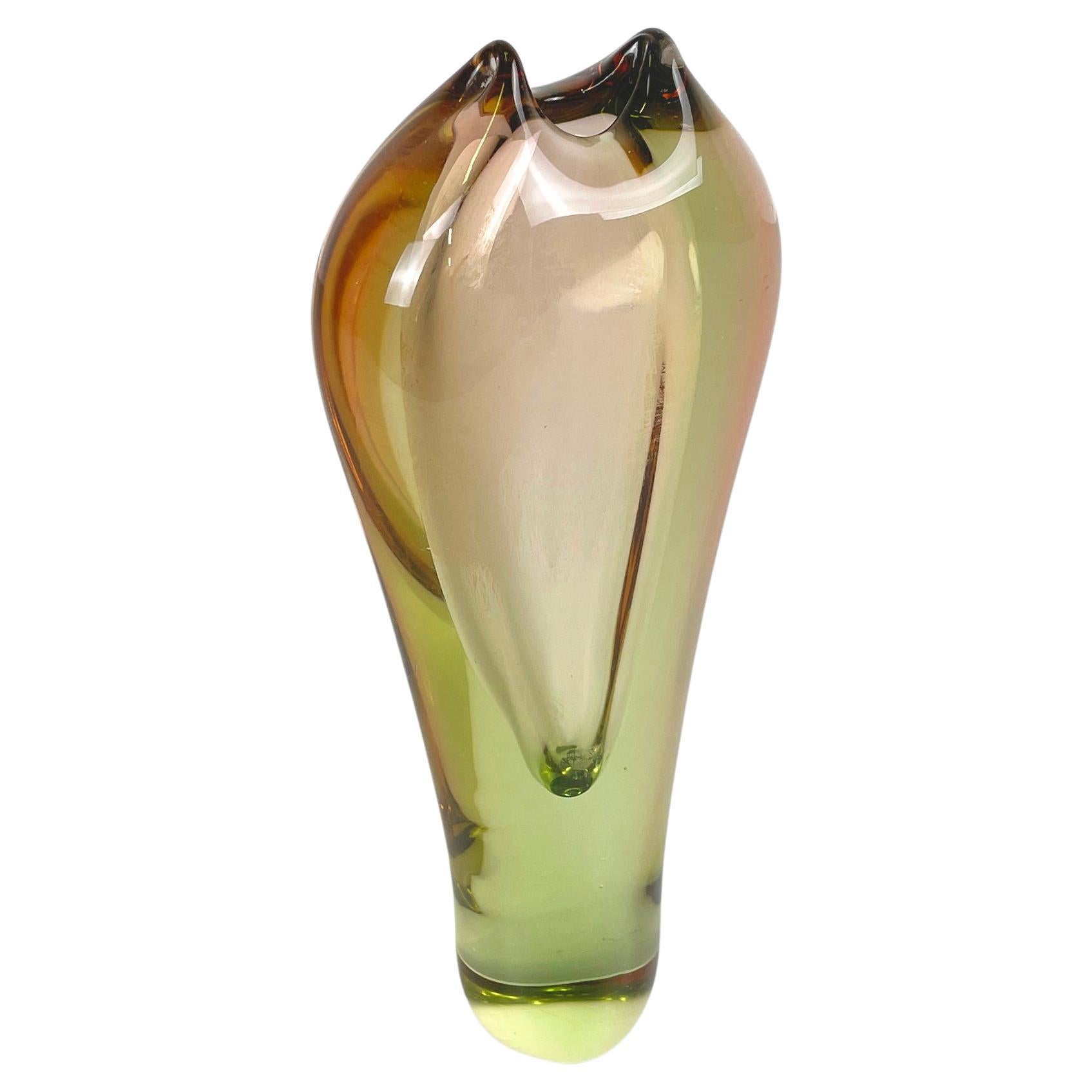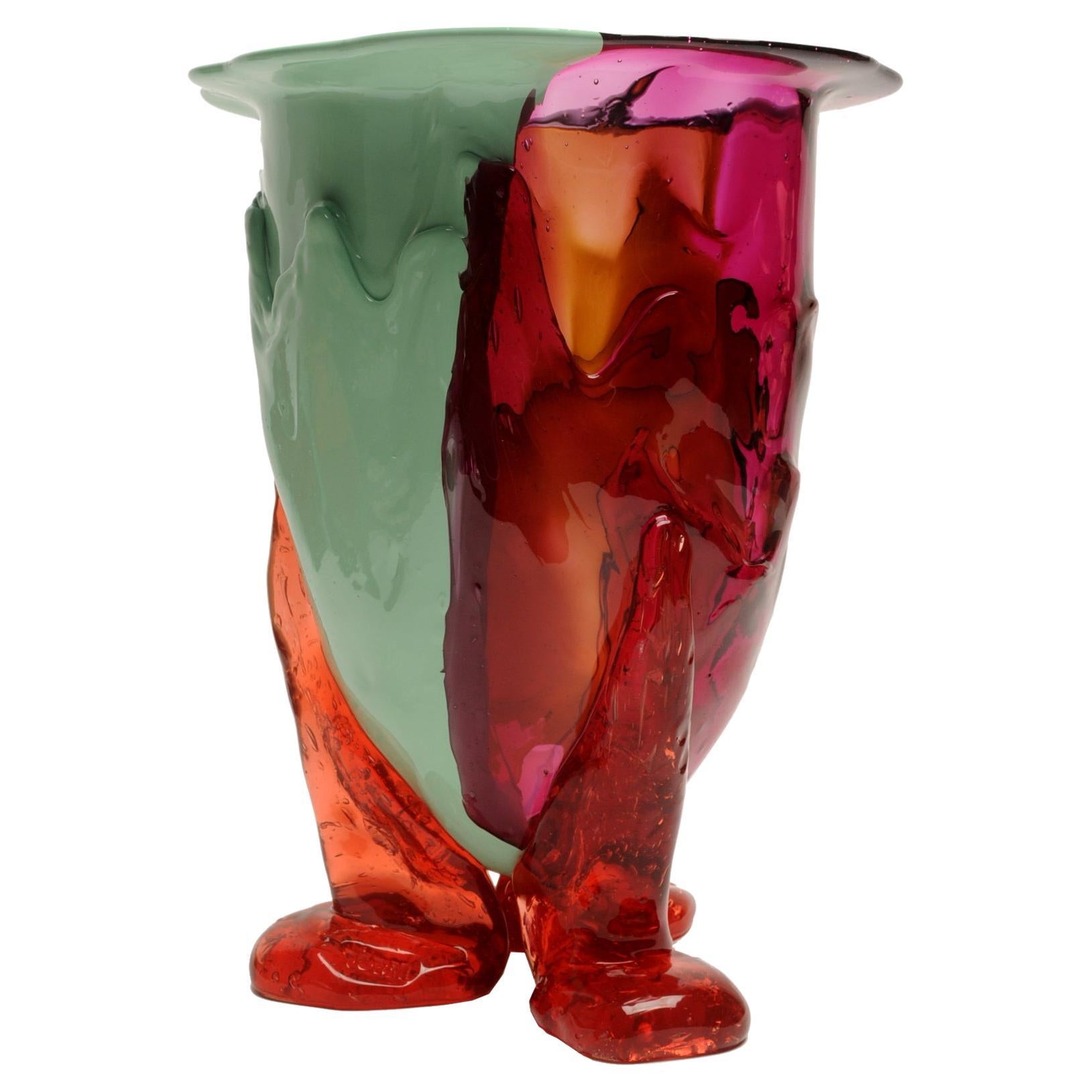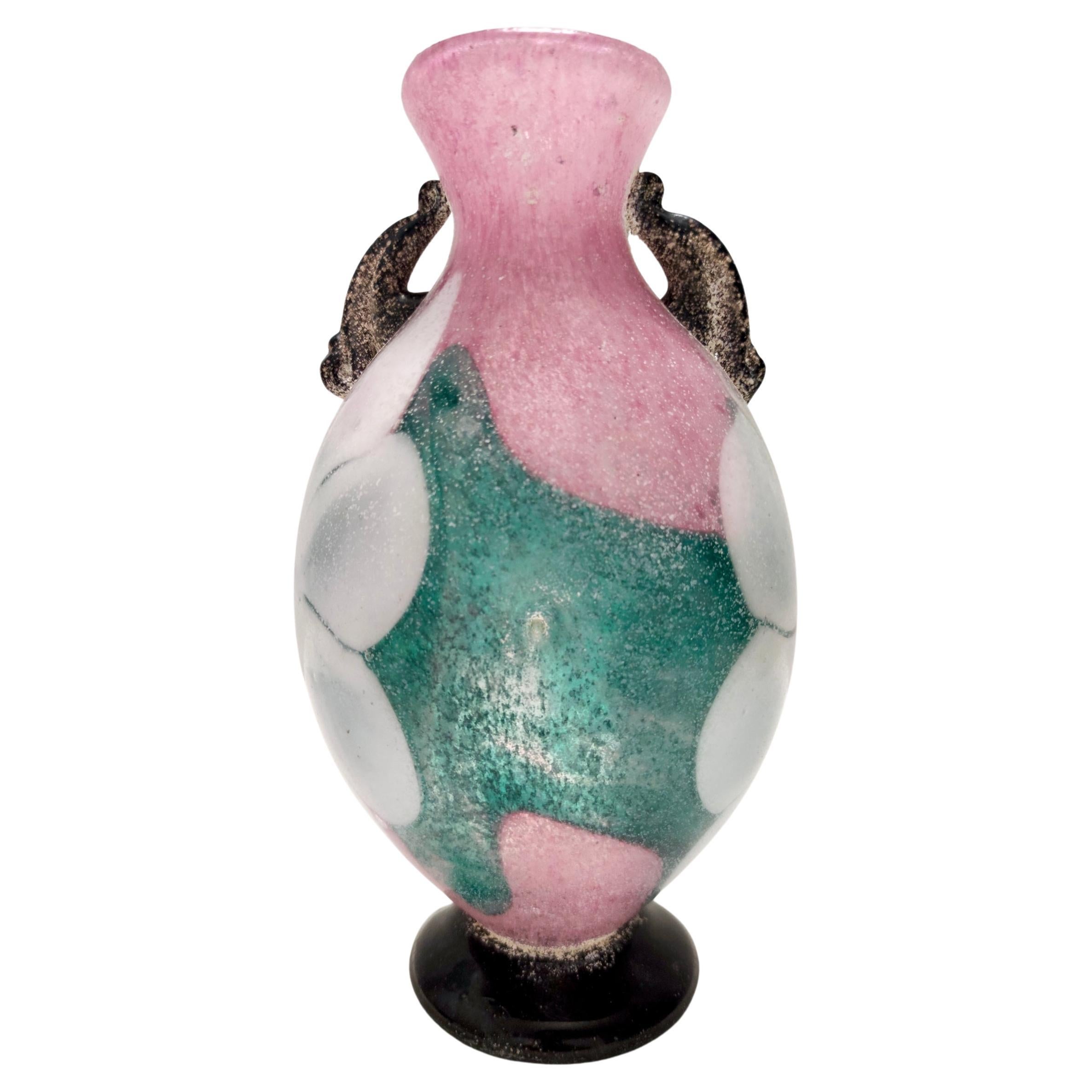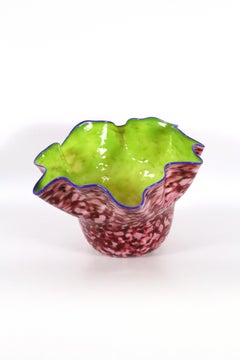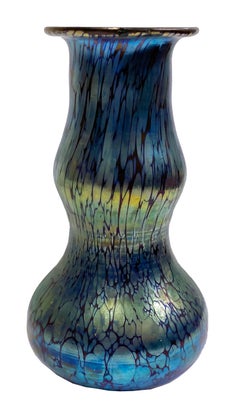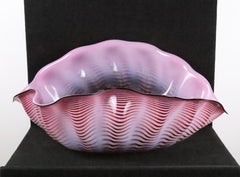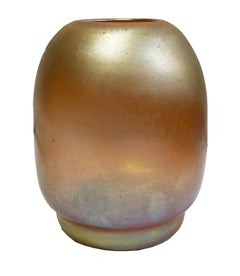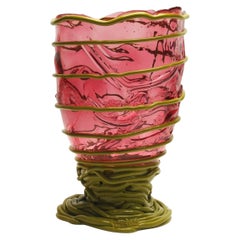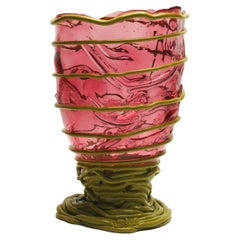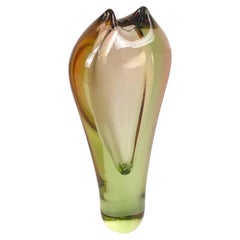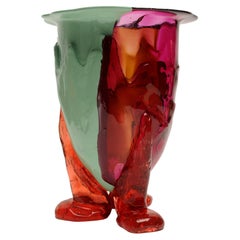Items Similar to Pink and Green Mizimah (Filet-de-verre Art Glass Vase)
Want more images or videos?
Request additional images or videos from the seller
1 of 15
Toots ZynskyPink and Green Mizimah (Filet-de-verre Art Glass Vase)c. 2005
c. 2005
Price Upon Request
Price Upon Request
Price Upon Request
Price Upon Request
Price Upon Request
Price Upon Request
Price Upon Request
Price Upon Request
Price Upon Request
Price Upon Request
About the Item
When I hear music, it translates into color. —Toots Zynsky
Toots Zynsky’s distinctive heat-formed filet de verre (glass thread) vessels enjoy a widespread popularity and deserved acclaim for their often extraordinary and always unique explorations in color. Defying categorization, her pieces inhabit a region all their own, interweaving the traditions of painting, sculpture, and the decorative arts.
Mary Ann Toots Zynsky was born in 1951 and raised in Massachusetts. Known professionally and to her friends as Toots Zynsky, she received her bachelor of fine arts in 1973 at the Rhode Island School of Design (RISD) in Providence. There, she was one of a group of pioneering artists studying with Dale Chihuly, who made studio glass a worldwide phenomenon.
“Glassmaking was wide open,” Zynsky remembers. “Hot glass slipped through the air, pulled and stretched. There was music and the furnaces were roaring. . . and everyone was working in concert. . . It was this material that hadn’t been widely explored as an artist’s medium. Everything was possible, and there was so much to be discovered. There were no rules. You could do anything you wanted.”
In Chihuly’s words, her class was a group with extraordinary energy, amounting to “the most creative, highly charged institutional experience I’d ever been a part of.” Among Zynsky’s classmates at RISD were other artists who went on to build successful careers, such as James Carpenter, Bruce Chao, Dan Dailey, and Therman Statom.
In the summer of 1971, Chihuly brought a small group of his friends and a few RISD students, including Zynsky, to Washington State. There, she participated in the founding and early development of Pilchuck Glass School. By early 1972, she was making installations with slumped plate glass. In 1973, she began experimenting with video and performance works that incorporated hot and cold glass with artist Buster Simpson. Her experimental work—which was characteristic of much of the art being made in the 1970s—was important for the development of glass as a material to explore issues in contemporary art.
“I still think that one of the best ways to learn about glass—and to start to have a deep understanding of it—is by blowing it,” Zynsky observes. “You learn that you have to work with glass, that you can’t just impose your desires on it, because it’s always doing something on its own. Glass moves, it’s hot, and you have to be moving with it. It breaks pretty quickly if you don’t do the right thing, which is one of the qualities about glass that I find strangely positive—the fact that it breaks.”
After her graduation from RISD in 1973, she traveled to the west coast to finish her degree project at Pilchuck Glass School, and then she returned to the east. “I started wondering what I was doing with glass and why,” Zynsky says. “There were other materials and ideas that fascinated me, and I started working with cloth, light, wire, and barbed wire. I was interested in barbed wire because it’s such a powerful symbol of the failure of humanity— that we had to come up with this material to keep each other apart.”
In 1980, Zynsky became assistant director and head of the hot shop at the New York Experimental Glass Workshop in New York City, which is now known as UrbanGlass and located in Brooklyn. At the Experimental Glass Workshop, she brought together her interests in barbed wire and glass. “I wanted to make a vessel that was a perfect heavy glass, a simple crystalline object enveloped in barbed wire,” she says. These experiments evolved into the “spun glass” vessels, such as the Museum’s pieces titled Promises and Other Misinformation (1981) and Waterspout No. 13 (conceived in 1979 and made in 1994).
By 1982, Zynsky was working on pieces combining fused nets of glass threads with blown forms. The Museum’s vessel, Clipped Grass, was included in her first exhibition at Theo Portnoy Gallery in New York City that year. “Clipped Grass was the first piece that I made entirely with threads,” Zynsky says. “But it was all hand-pulled thread, thicker and more uneven.” She gave a name to the new technique that she developed, calling it “filet de verre,” or layers of glass threads that are fused and hot-formed inside of a kiln.
At this time, Zynsky was making her glass threads in the hotshop, in the traditional Venetian manner of making cane. “An acquaintance, Mathijs Teunissen Van Manen, came to New York from Amsterdam and saw my show at Theo Portnoy,” she says. Curious about how she made her work—because he had never seen glass treated that way—Van Manen went to to the New York Experimental Glass Workshop to see what Zynsky was up to. “I had two teams of people pulling thread all afternoon for me,” Zynsky recalls. “Mathijs took one look at this, shook his head, and said, ‘This is medieval!’” Within 24 hours, Van Manen had constructed a contraption that fed a glass rod through a flame, turning it into a glass thread.
Several months later, in early 1983, Zynsky set off on a three-week trip to Europe, and she ended up staying there for 16 years. Settling in Amsterdam, she and Van Manen collaborated on the development of the glass thread-pulling machine. Now incorporating sophisticated electronics and custom software, these unique machines, which make thread in a manner not unlike how glass optical fiber is made, are still used by her.
In 1984, Zynsky was invited to the famous Venini glassworks on Murano. While she was there, she reconsidered her early, thread-wrapped blown vessels. The result was the unusual Folto vases that she designed for Venini, in contrasting colors, two of which are included in the Museum’s collection.
She also had an important insight into her own work while she was at Venini. One day, a group of architects came to watch her make a fused thread vessel, using a small, collapsible kiln, designed and built with Van Manen, that she had brought to Italy. “The architects were so curious and I was so nervous and the piece just wasn’t going right,” Zynsky says. “All of a sudden, I reached into the kiln, grabbed the vessel, and gave it a big squeeze. Finally, I had the form that I wanted! And I thought, Why didn’t I think of this before? I was fed up with the piece, so I tried something different because I had nothing to lose.”
In late 1984, she traveled to Ghana, West Africa to work on a special project recording traditional music. The experience of living and working in Africa, which lasted six months, had a significant impact on her work for many years afterward.
In 1988, the Corning Museum awarded Zynsky its annual Rakow Commission, and the two vessels that she made for the Commission show her strong palette, influenced by African textiles, and her manipulation of the rims of the vessels while hot.
While maintaining a studio in Amsterdam, she moved to Paris in 1990. In her studios in Amsterdam and Paris, she made series of vessels in which she developed her color combinations and her technique. When discussing her characteristic vessel form, Zynsky explains, “I have inside, outside, back of the inside, and the other side. You can never see the whole piece at once. There’s always something mysterious, no matter what angle or in what light you’re looking at the piece. It forces you to move around it.”
To make her vessels, Zynsky first layers thousands of multicolored glass threads onto a round heat-resistant fiberboard plate. For her, this part of the process is like drawing or painting. This mass of glass threads is then fused inside a kiln. While hot, the fused thread disk is allowed to slowly slump into a series of consecutively deeper and rounder preheated bowl-shaped metal forms. To make taller vessels, the piece is turned upside down and slumped over a cone-shaped mold. Finally, Zynsky reaches into the kiln, wearing special heat-resistant gloves, and she squeezes the glass into a unique undulating form.
In 1999, Zynsky and her family moved from Europe to the United States, establishing themselves in Providence, Rhode Island where Zynsky lives and works today.
Throughout her career, she has enjoyed the teamwork necessary for most glassworking processes, yet her “filet de verre” technique also allows her to work alone on individual pieces. Exceptions to this are the very large forms, such as the Museum’s Maestrale, which was commissioned by Ben and Natalie Heineman in 2005. This vessel was so large that she needed extra assistants to help her get the piece in and out of the kiln during its firing cycle.
Zynsky’s most recent work is represented in the museum’s collection by Incantatrice, or “sorceress.” Abandoning her variegated palette, she began to focus on black, gray, and red, gradually adding amber. “They are colors, but they’re the same to me as no color because they’re so powerful,” she explains. “They’re not pretty colors, like pink or green or blue. They are powerful colors, life and death colors.”
Zynsky has made a life’s work of studying and manipulating colored glass through the vehicle of her distinctive, undulating forms. Continually evolving, her work is a formal exploration in color and composition that has no end.
Her glass vessels are represented in over 70 international museum collections, including the Boymans van Beuningen Museum, Rotterdam, The Netherlands; Carnegie Museum of Art, Pittsburgh, PA; Cleveland Museum of Art, Cleveland, OH; Cooper-Hewitt National Design Museum, Smithsonian Institution, New York, NY; Corning Museum of Glass, Corning, NY; Fine Arts Museums of San Francisco, San Francisco, CA; Detroit Institute of Arts, Detroit, MI; Hokkaido Museum of Modern Art, Sapporo, Japan; Kunstammlungen der Veste-Coburg, Coburg, Germany; Metropolitan Museum of Art, New York, NY; Montreal Museum of Fine Arts, Montreal, Quebec, Canada; Musée de Design et d’Arts Appliqués (mudac), Lausanne, Switzerland; Musée des Arts Décoratifs du Louvre, Paris, France; Musei Civici Veneziani (Museo Correr), Venice, Italy; Museum of Arts and Design, New York, NY; Museum of Fine Arts, Houston, TX; Museum of Fine Arts, Boston, MA; Museum of Modern Art, New York, NY; Museum für Kunst und Gewerbe, Hamburg, Germany; National Gallery of Australia, Canberra, ACT, Australia;
National Museum of American Art (Renwick Gallery), Smithsonian Institution, Washington, DC; New Orleans Museum of Art, New Orleans, LA; Newark Museum, Newark, NJ; Norton Museum of Art, West Palm Beach, FL;
Philadelphia Museum of Art, PA; Powerhouse Museum, Sydney, NSW, Australia; Racine Art Museum, Racine, WI; St. Louis Museum of Art, St. Louis, MS; Stedelijk Museum, Amsterdam, The Netherlands; Toledo Museum of Art, Toledo, OH; Victoria and Albert Museum, London, United Kingdom.
Tina Oldknow
The Corning Museum of Glass
About the Seller
5.0
Vetted Professional Seller
Every seller passes strict standards for authenticity and reliability
Established in 1970
1stDibs seller since 2017
156 sales on 1stDibs
Typical response time: Several days
- ShippingRetrieving quote...Shipping from: Missouri, MO
- Return Policy
Authenticity Guarantee
In the unlikely event there’s an issue with an item’s authenticity, contact us within 1 year for a full refund. DetailsMoney-Back Guarantee
If your item is not as described, is damaged in transit, or does not arrive, contact us within 7 days for a full refund. Details24-Hour Cancellation
You have a 24-hour grace period in which to reconsider your purchase, with no questions asked.Vetted Professional Sellers
Our world-class sellers must adhere to strict standards for service and quality, maintaining the integrity of our listings.Price-Match Guarantee
If you find that a seller listed the same item for a lower price elsewhere, we’ll match it.Trusted Global Delivery
Our best-in-class carrier network provides specialized shipping options worldwide, including custom delivery.More From This Seller
View AllZephyr Green Macchia with Blue Lip Wrap
By Dale Chihuly
Located in Missouri, MO
Zephyr Green Macchia with Blue Lip Wrap, 1996
Dale Chihuly (American, b. 1941)
8 x 10 x 10 inches
Signed and Dated on Bottom
Born in Tacoma, Washington, Dale Chihuly became the most...
Category
1990s American Modern Abstract Sculptures
Materials
Glass, Blown Glass
Diaspora Vase
By Loetz Glass
Located in Missouri, MO
Loetz
Diaspora Vase, c. 1900
Glass
Stamped on bottom
6 inches tall
3 inches diameter
This Loetz vase in the Papillon pattern has blue iridescent Papillon design covering the exterio...
Category
Early 20th Century Art Nouveau More Art
Materials
Glass
Cameo Pink Seaform with Black Lip Wrap (94.678.s1)
By Dale Chihuly
Located in Missouri, MO
Cameo Pink Seaform with Black Lip Wrap (94.678.s1), 1994
Dale Chihuly (American, b. 1941)
14 x 32 x 18 inches
Born in Tacoma, Washington, Dale Chihuly became the most famous ornate ...
Category
1990s American Modern Abstract Sculptures
Materials
Glass, Blown Glass
Gold Iridescence Vase
By Durand
Located in Missouri, MO
Durand
Gold Iridescence Vase
Glass
Signed on bottom (enameled with numbering)
5 x 3.5 inches
Victor Durand, Jr. was born in Baccarat, France. As several generations before him, Victor, at the age of 12, went to work in a local glassworks. Victor's grandfather and father worked for Cristalleries de Baccarat, a famous glassworks that was established in 1764. In 1882, Victor Durand, Sr. immigrated to the U.S. Victor, Sr. worked for Wheaton Glass...
Category
Early 20th Century Art Nouveau More Art
Materials
Glass
Courde (Gourd) Bowl
Located in Missouri, MO
Gabriel Argy-Rousseau (1885-1953)
Gourds Bowl c. 1922
Glass
Signed
3.75 x 4.5 inches
This G. Argy-Rousseau bowl has a very distinct arts and crafts feel...
Category
Early 20th Century Art Deco More Art
Materials
Glass
Juan Tafoya San Ildefonso Native American Pottery
By Juan Tafoya
Located in Missouri, MO
Impeccable Provenance! See attached pictures of Juan Tafoya holding this particular piece, as well as his business card and his original letter all include...
Category
1980s American Modern More Art
Materials
Clay
Price Upon Request
You May Also Like
Contemporary Gaetano Pesce Pompitu II Vase M Resin Light Fuchsia Green
By Gaetano Pesce
Located in barasso, IT
Pompitu II vase, clear light fuchsia, matt dust green.
Vase in soft resin designed by Gaetano Pesce in 1995 for Fish Design collection.
Measures: M - ø 16cm x H 26cm
Colours: Clear...
Category
21st Century and Contemporary Italian Modern Vases
Materials
Resin
Contemporary Gaetano Pesce Pompitu II Vase L Soft Resin Light Fuchsia Matt Green
By Gaetano Pesce
Located in barasso, IT
Pompitu II vase, clear light fuchsia, matt dust green.
Vase in soft resin designed by Gaetano Pesce in 1995 for Fish Design collection.
Measures: L ø 22cm x H 36cm
Colours: Clear li...
Category
21st Century and Contemporary Italian Modern Vases
Materials
Resin
Italian modern oval pink and green Murano glass vase by i Sommersi series, 1970s
Located in MIlano, IT
Italian modern oval pink and green Murano glass vase by i Sommersi series, 1970s
Oval-based vase entirely in thick Murano glass. The glass has di...
Category
Vintage 1970s Italian Modern Decorative Bowls
Materials
Murano Glass
Fish Design Gaetano Pesce Amazonia L Vase Resin, Mint, Fuchsia, Pink
Located in barasso, IT
Amazonia vase - matt mint, clear brown, clear fuchsia and clear pink.
Vase in soft resin designed by Gaetano Pesce in 1995 for Fish Design collection.
Measures: L Ø 22 cm x H 36 cm...
Category
21st Century and Contemporary Italian Arts and Crafts Vases
Materials
Resin
Contemporary Gaetano Pesce Amazonia M Vase Resin, Mint, Brown, Fuchsia, Pink
Located in barasso, IT
Amazonia vase - Matt mint, clear brown, clear fuchsia and clear pink
Vase in soft resin designed by Gaetano Pesce in 1995 for Fish Design collection.
Measures: M - ø 16cm x H 26cm
...
Category
21st Century and Contemporary Italian Arts and Crafts Vases
Materials
Resin
Postmodern Pink, Green and White Hand Blown Scavo Glass Vase, Murano, Italy
Located in Bresso, Lombardy
Made in Murano, Italy, 1970s - 1980s.
Its texture and lines make it look like it's been taken out from a painting.
It is an amazing piece with an intense ornamental and chromatic eff...
Category
Vintage 1970s Italian Post-Modern Vases
Materials
Murano Glass
More Ways To Browse
Murano Art Glass Large Green
Green Glass Sculpture
Green And Pink Glass
Green And Pink Glasses
Pink Glass Sculpture
End Of The Day Vase
Murano Vase Red Blue Green
Pink And Green Vase
Slump Glass
Murano Abstract Blown Glass Bowl
End Of Day Glass Cane
Toots Zynsky Glass
Mariusz Dydo
Marko Kratohvil On Sale
Mars1 Mario Martinez
Mary Rose Young
Michael Wisner Pottery
Nathan Lynch
